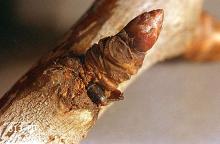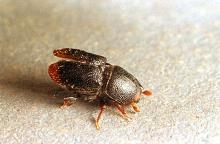Includes
Ambrosia beetles (Xyleborinus spp.)
Shothole borer (Scolytus rugulosus)
Pest description and crop damage Shothole borers are small beetles introduced to North America and have been found in the PNW since the early 1900s. They are pests of forest trees, ornamental shade trees, and shrubs as well as fruit trees. Apple, pear, cherry, and plum are all attacked. Borers are primarily a problem on injured or stressed plants, but healthy trees growing adjacent to blocks of neglected trees, or infested wood piles may be attacked. The adult shothole borer is a brownish black beetle about 0.1 inch in length. The larvae are white, legless, and about 0.15 inch long. A similar wood-boring beetle, the ambrosia beetle, is more cigar-shaped, about 0.1 inch long, dark brown or black, and covered with yellowish hairs. The larva is pinkish-white, legless, cylindrical, and 0.1 inch in length when mature. Larvae and adults of both these species bore into the cambial and vascular tissues of trees, weakening them and causing wilting and dieback of individual stems and branches. Trunks and branches can become completely riddled with galleries.
Biology and life history Shothole borer overwinters as a larva in burrows beneath the bark of infested trees. They pupate within the tree. Adults emerge in spring or early summer, mate, and fly to susceptible trees to feed at the base of leaves or small twigs. Adults then tunnel into the tree, excavating galleries parallel to the wood grain. They lay eggs along the gallery. The eggs hatch, and the larvae feed by tunneling at right angles to the main burrow, causing a characteristic pattern of damage. The burrows are filled with frass (excrement) and increase in diameter as the larvae mature. After 6 to 8 weeks, the larvae pupate at the ends of the galleries then emerge as adults starting in August. There are many small, round, exit holes that give the host's branch a "shothole" effect. There are two generations per year.
Ambrosia beetles overwinter as mature larvae, pupae, or adults in galleries in the tree. When spring temperatures exceed 65°F, the females become active, fly to susceptible hosts, and bore into the tree. Eggs are laid in the gallery, and as they develop, the female carefully tends them and cultivates ambrosia fungus for them to eat. The females usually remove excrement or wood dust from the tunnels, and this, along with the uniform width of the galleries, distinguishes them from other wood-boring beetles. Young adults are found tightly packed in the galleries in midsummer, where they remain until the following spring. There is only one generation per year.
Pest monitoring Examine branches in late spring for holes about 0.08 inch in diameter, oozing sap and sawdust. In stone fruits, these holes often are sealed with gummy ooze. Beetles particularly are attracted to unhealthy trees.
Management-cultural control
The best management tool is to keep trees healthy with proper pruning, adequate water, and fertilizer. Healthy trees repel the beetles by plugging bore holes with sap and resins. Remove and destroy infested wood on the tree or piles of infested green wood nearby, especially cherry wood. Once the bark on cut wood dries and sloughs off, it is no longer a host for the beetles. Whitewash trunks of young trees to prevent sunburn, and thus reduce potential hazard of attack by shothole borer and flathead borers.
Management-chemical control: HOME USE
Utilization of cultural techniques are typically the best management practices.
No effective insecticides are registered.
Management-chemical control: COMMERCIAL USE
No products are registered for control of this pest.




